The Sensitivityof GPS Precipitable Water Vapor Jumps to Intense Precipitation Associated with Tropical Organized Convective Systems
Abstract
:1. Introduction
2. Materials and Methods
2.1. Data Collection Strategy
2.2. GPS Processing Methodology
2.3. Radar Data Processing Methodology
2.4. GOES Satellite Data
2.5. The GPS Station Selection to Study the Organized Convection Events
3. Results and Discussion
3.1. Organized Convection and GPS-PWV Jumps
3.1.1. Characterization of Organized Convection
3.1.2. Pressure, Temperature, and GPS-PWV Time Series Behavior during Organized Convective Systems
3.2. The Sensitivityof GPS-PWV Jumps to Forecast Precipitation Associated with Organized Convective Systems
4. Conclusions
Author Contributions
Funding
Data Availability Statement
Acknowledgments
Conflicts of Interest
References
- Bevis, M.; Businger, S.; Herring, T.A.; Rocken, C.; Anthes, R.A.; Ware, R.H. GPS meteorology: Remote sensing of atmospheric water vapor using the global positioning system. J. Geophys. Res. 1992, 97, 15787–15801. [Google Scholar] [CrossRef]
- Rocken, C.; Ware, R.; Van Hove, T.; Solheim, F.; Alber, C.; Johnson, J.; Bevis, M.; Businger, S. Sensing atmospheric water vapor with the global positioning system. Geophys. Res. Lett. 1993, 20, 2631–2634. [Google Scholar] [CrossRef] [Green Version]
- Rocken, C.; Van Hove, T.; Johnson, J.; Solheim, F.; Ware, R.; Bevis, M.; Chiswell, S.; Businger, S. TGPS/STORM—GPS Sensing of Atmospheric Water Vapor for Meteorology. J. Atmos. Ocean Technol. 1995, 12, 468–478. [Google Scholar] [CrossRef]
- Bonafoni, S.; Riccardo, B. The usefulness of the Global Navigation Satellite Systems (GNSS) in the analysis of precipitation events. Atmos. Res. 2016, 167, 15–23. [Google Scholar] [CrossRef]
- Cucurull, L.; Vandenberghe, F.; Barker, D.; Vilaclara, E.; Rius, A. Three-dimensional variational data assimilation of ground-based GPS ZTD and meteorological observations during the 14 December 2001 storm event over the western Mediterranean sea. Mon. Weather Rev. 2004, 132, 749–763. [Google Scholar] [CrossRef]
- Gutman, S.; Sahm, S.; Benjamin, S.; Schwartz, B.; Holub, K.; Stewart, J.; Smith, T. Rapid Retrieval and Assimilation of Ground Based GPS Precipitable Water Observations at the NOAA Forecast Systems Laboratory: Impact on Weather Forecasts. J. Meteorol. Soc. JPN 2004, 82, 351–360. [Google Scholar]
- Bennitt, G.V.; Jupp, A. Operational assimilation of GPS zenith total delay observations into the Met Office numerical weather prediction models. Mon. Weather Rev. 2012, 140, 2706–2719. [Google Scholar] [CrossRef]
- Risanto, C.B.; Castro, C.L.; Arellano, A.F.; Moker, J.M.; Adams, D.K. The Impact of Assimilating GPS Precipitable Water Vapor in Convective-Permitting WRF-ARW on North American Monsoon Precipitation Forecasts over Northwest Mexico. Mon. Weather Rev. 2021, 149, 3013–3035. [Google Scholar]
- Jerrett, D.; Nash, J. Potential uses of surface based GPS water vapour measurements for meteorological purposes. Phys. Chem. Earth Part A Solid Earth Geod. 2001, 26, 457–461. [Google Scholar] [CrossRef]
- Mazany, R.A.; Businger, S.; Gutman, S.I.; Roeder, W. A Lightning Prediction Index that Utilizes GPS Integrated Precipitable Water Vapor. Weather Forecast. 2002, 17, 1034–1047. [Google Scholar]
- De Haan, S.; Barlag, S.; Baltink, H.K.; Debie, F.; Van der Marel, H. Synergetic use of GPS water vapor and Meteosat images for synoptic weather forecasting. J. Appl. Meteorol. 2004, 43, 514–518. [Google Scholar] [CrossRef]
- Kursinski, E.R.; Bennett, R.A.; Gochis, D.; Gutman, S.I.; Holub, K.L.; Mastaler, R.; Minjarez Sosa, C.; Minjarez Sosa, I.; Van-Hove, T. Water vapor and surface observations in northwestern Mexico during the 2004 NAME Enhanced Observing Period. Geophys. Res. Lett. 2008, 35, 4–9. [Google Scholar] [CrossRef] [Green Version]
- Adams, D.K.; Gutman, S.I.; Holub, K.L.; Pereira, D.S. GNSS observations of deep convective time scales in the Amazon. Geophys. Res. Lett. 2013, 40, 2818–2823. [Google Scholar] [CrossRef]
- Benevides, P.; Catalao, J.; Miranda, P.M.A. On the inclusion of GPS precipitable water vapour in the nowcasting of rainfall. Nat. Hazards Earth Syst. Sci. 2015, 15, 2605–2616. [Google Scholar] [CrossRef] [Green Version]
- Bastin, S.; Champollion, C.; Bock, O.; Drobinski, P.; Masson, F. On the use of GPS tomography to investigate water vapor variability during a Mistral/sea breeze event in southeastern France. Geophys. Res. Lett. 2005, 32. [Google Scholar] [CrossRef] [Green Version]
- Miranda, P.M.A.; Mateus, P. Improved GNSS Water Vapor Tomography With Modified Mapping Functions. Geophys. Res. Lett. 2022, 49, e2022GL100140. [Google Scholar] [CrossRef]
- Adams, D.K.; Fernandes, R.M.S.; Holub, K.L.; Gutman, S.I.; Barbosa, H.M.J.; Machado, L.A.T.; Calheiros, A.J.P.; Bennett, R.A.; Kursinski, E.R.; Sapucci, L.F.; et al. The amazon dense gnss meteorological network a new approach for examining water vapor and deep convection interactions in the tropics. Bull. Am. Meteorol. Soc. 2015, 96, 2151–2165. [Google Scholar] [CrossRef]
- Adams, D.K.; Barbosa, H.M.J.; Gaitan de los Rios, K.P. A Spatiotemporal Water Vapor–Deep Convection Correlation Metric Derived from the Amazon Dense GNSS Meteorological Network. Mon. Weather Rev. 2017, 145, 279–288. [Google Scholar] [CrossRef]
- Muller, C.J.; Back, L.E.; O’Gorman, P.A.; Emanuel, K.A.T. A model for the relationship between tropical precipitation and column water vapor. Geophys. Res. Lett. 2009, 36, L16804. [Google Scholar] [CrossRef]
- Holloway, C.E.; Neelin, J.D. Moisture vertical structure, column water vapor, and tropical deep convection. J. Atmos. Sci. 2009, 66, 1665–1683. [Google Scholar] [CrossRef] [Green Version]
- Madhulatha, A.; Rajeevan, M.; Venkat-Ratnam, M.; Bhate, J.; Naidu, C.V. Nowcasting severe convective activity over southeast India using ground-based microwave radiometer observations. J. Geophys. Res. Atmos. 2013, 118, 1–13. [Google Scholar] [CrossRef] [Green Version]
- De Haan, S. Measuring Atmospheric Stability with GPS. J. Appl. Meteorol. Climatol. 2006, 45, 467–475. [Google Scholar] [CrossRef]
- Sapucci, L.F.; Machado, L.A.T.; Souza, E.; Campos, T. Global Positioning System precipitable water vapor (GPS-PWV) jumps before intense rain events: A potential application to nowcasting. Meteorol. Appl. 2019, 26, 49–63. [Google Scholar] [CrossRef]
- Guerova, G.; Dimitrova, T.; Georgiev, S. Thunderstorm Classification Functions Based on Instability Indices and GNSS IWV for the Sofia Plain. Remote Sens. 2019, 11, 2988. [Google Scholar] [CrossRef] [Green Version]
- Machado, L.A.T.; Silva Dias, M.A.F.; Morales, C.; Fisch, G.; Vila, D.; Albrecht, R.; Goodman, S.J.; Calheiros, A.J.P.; Biscaro, T.; Kummerow, C.; et al. The Chuva Project: How Does Convection Vary across Brazil? Bull. Am. Meteorol. Soc. 2014, 95, 1365–1380. [Google Scholar] [CrossRef]
- Garstang, M.; Massie, H.L.; Halverson, J.; Greco, S.; Scala, J. Amazon coastal squall lines. Part I: Structure and kinematics. Mon. Weather Rev. 1994, 122, 608–622. [Google Scholar] [CrossRef]
- Cohen, J.C.P.; Silva Dias, M.A.F.; Nobre, C.A. Environmental Conditions Associated with Amazonian Squall Lines: A Case Study. Mon. Weather Rev. 1995, 123, 3163–3174. [Google Scholar] [CrossRef]
- Lyard, F.; Lefevre, F.; Letellier, T.; Francis, O. Modelling the global ocean tides: Modern insights from FES2004. Ocean Dynam. 2006, 56, 394–415. [Google Scholar] [CrossRef]
- Schmid, R.; Steigenberger, P.; Gendt, G.; Ge, M.; Rothacher, M. Generation of a consistent absolute phase-center correction model for GPS receiver and satellite antennas. J. Geod. 2007, 81, 781–798. [Google Scholar] [CrossRef] [Green Version]
- Montenbruck, O.; Schmid, R.; Mercier, F.; Steigenberger, P.; Noll, C.; Fatkulin, R.; Kogure, S.; Ganeshan, A.S. GNSS satellite geometry and attitude models. Adv. Space Res. 2015, 56, 1015–1029. [Google Scholar] [CrossRef] [Green Version]
- Boehm, J.; Werl, B.; Schuh, H. Troposphere mapping functions for GPS and very long baseline interferometry from European Centre for Medium-Range Weather Forecasts operational analysis data. J. Geophys. Res. 2006, 111, 1–9. [Google Scholar] [CrossRef]
- Davis, J.L.; Herrinch, T.A.; Shapiro, I.I.; Rollers, A.E.E.; Elglered, G. Geodesy by radio interferometry: Effects of atmospheric modeling errors on estimates of baseline length. Radio Sci. 1985, 20, 1593–1607. [Google Scholar] [CrossRef]
- Bevis, M.; Businger, S.; Chiswell, S.; Herring, T.A.; Anthes, R.A.; Rocken, C.; Ware, R.H. GPS Meteorology: Mapping Zenith Wet Delays onto Precipitable Water. J. Appl. Meteorol. Climatol. 1994, 33, 379–386. [Google Scholar] [CrossRef]
- Sapucci, L.F. Evaluation of Modeling Water-Vapor-Weighted Mean Tropospheric Temperature for GNSS-Integrated Water Vapor Estimates in Brazil. J. Appl. Meteorol. Climatol. 2014, 53, 715–730. [Google Scholar] [CrossRef]
- Testud, J.; Le Bouar, E.; Obligis, E.; Ali-Mehenni, M. The Rain Profiling Algorithm Applied to Polarimetric Weather Radar. J. Atmos. Ocean Technol. 2000, 17, 332–356. [Google Scholar] [CrossRef]
- Calheiros, A.J.P.; Machado, L.A.T. Cloud and rain liquid water statistics in the CHUVA campaign. Atmos. Res. 2014, 144, 126–140. [Google Scholar] [CrossRef]
- Park, S.-G.; Bringi, V.N.; Chandrasekar, V.; Maki, M.; Iwanami, K. Correction of Radar Reflectivity and Differential Reflectivity for Rain Attenuation at X Band. Part I: Theoretical and Empirical Basis. J. Atmos. Ocean Technol. 2005, 22, 1621–1632. [Google Scholar] [CrossRef] [Green Version]
- Marshall, J.S.; Palmer, W.K.M. The distribution of raindrops with size. J. Meteorol. 1948, 5, 165–166. [Google Scholar] [CrossRef]
- Vila, D.A.; Machado, L.A.T.; Laurent, H.; Velasco, I. Forecast and Tracking the Evolution of Cloud Clusters (ForTraCC) Using Satellite Infrared Imagery: Methodology and Validation. Weather Forecast. 2008, 23, 233–245. [Google Scholar] [CrossRef]
- Madhulatha, A.; Tsmohan, M.; Thampi, S.B. Observational aspects of tropical mesoscale convective systems over southeast India. J. Earth Syst. Sci. 2020, 129, 1–26. [Google Scholar] [CrossRef]
- Salio, P.; Nicolini, M.; Zipser, E.J. Mesoscale Convective Systems over Southeastern South America and Their Relationship with the South American Low-Level Jet. Mon. Weather Rev. 2007, 135, 1290–1309. [Google Scholar] [CrossRef] [Green Version]
- Anselmo, E.M.; Machado, L.A.T.; Schumacher, C.; Kiladis, G.N. Amazonian mesoscale convective systems: Life cycle and propagation characteristics. Int. J. Climatol. 2021, 41, 3968–3981. [Google Scholar] [CrossRef]
- Oliveira, F.P.; Oyama, M.D. Antecedent Atmospheric Conditions Related to Squall-Line Initiation over the Northern Coast of Brazil in July. Weather Forecast. 2015, 30, 1254–1264. [Google Scholar] [CrossRef]
- Kousky, V.E. Diurnal rainfall variation in northeast Brazil. Mon. Weather Rev. 1980, 108, 488–498. [Google Scholar] [CrossRef]
- Ding, J.; Yang, Y.; Ye, Q.; Huang, Y.; Ma, X.; Ma, L.; Guo, Y.R. Moisture analysis of a squall line case based on precipitable water vapor data from a ground-based GPS network in the Yangtze River Delta. Adv. Atmos. Sci. 2007, 24, 409–420. [Google Scholar] [CrossRef]
- Derbyshire, S.H.; Beau, I.; Bechtold, P.; Grandpeix, J.Y.; Piriou, J.M.; Redelsperger, J.L.; Soares, P.M.M. Sensitivity of moist convection to environmental humidity. Q. J. R. Meteorol. Soc. 2004, 130, 3055–3079. [Google Scholar] [CrossRef]
- Zhang, Y.; Klein, S.A. Mechanisms affecting the transition from shallow to deep convection over land: Inferences from observations of the diurnal cycle collected at the ARM southern great plains site. J. Atmos. Sci. 2010, 67, 2943–2959. [Google Scholar] [CrossRef]
- Gamache, J.F.; Houze, R.A., Jr. Mesoscale air motions associated with a tropical squall line. Mon. Weather Rev. 1982, 10, 118–135. [Google Scholar] [CrossRef]
- Wilks, D. Statistical methods in the atmospheric sciences. In Statistical Methods in the Atmospheric Sciences, 3rd ed.; Academic Press: Cambridge, MA, USA, 1995. [Google Scholar]
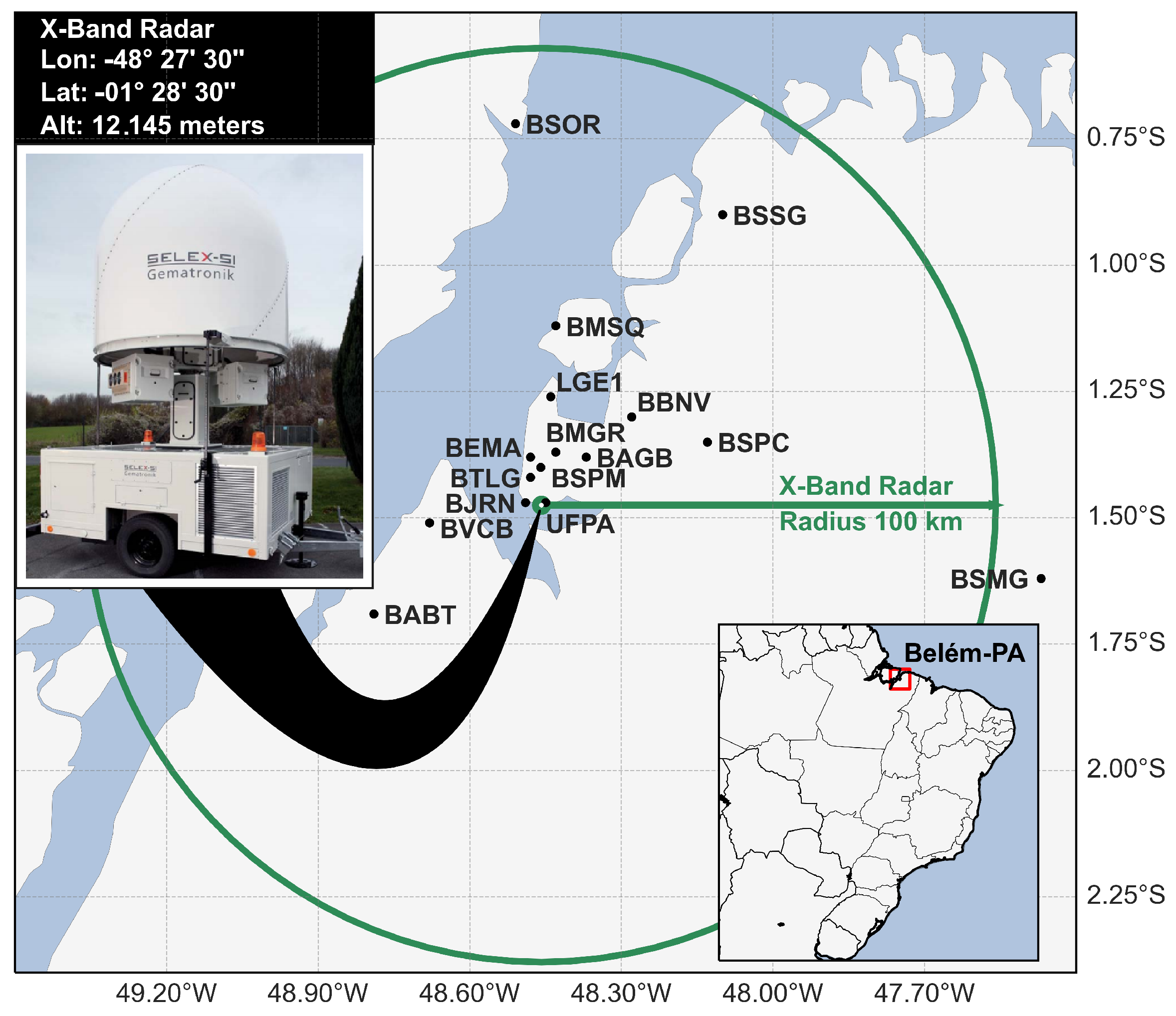
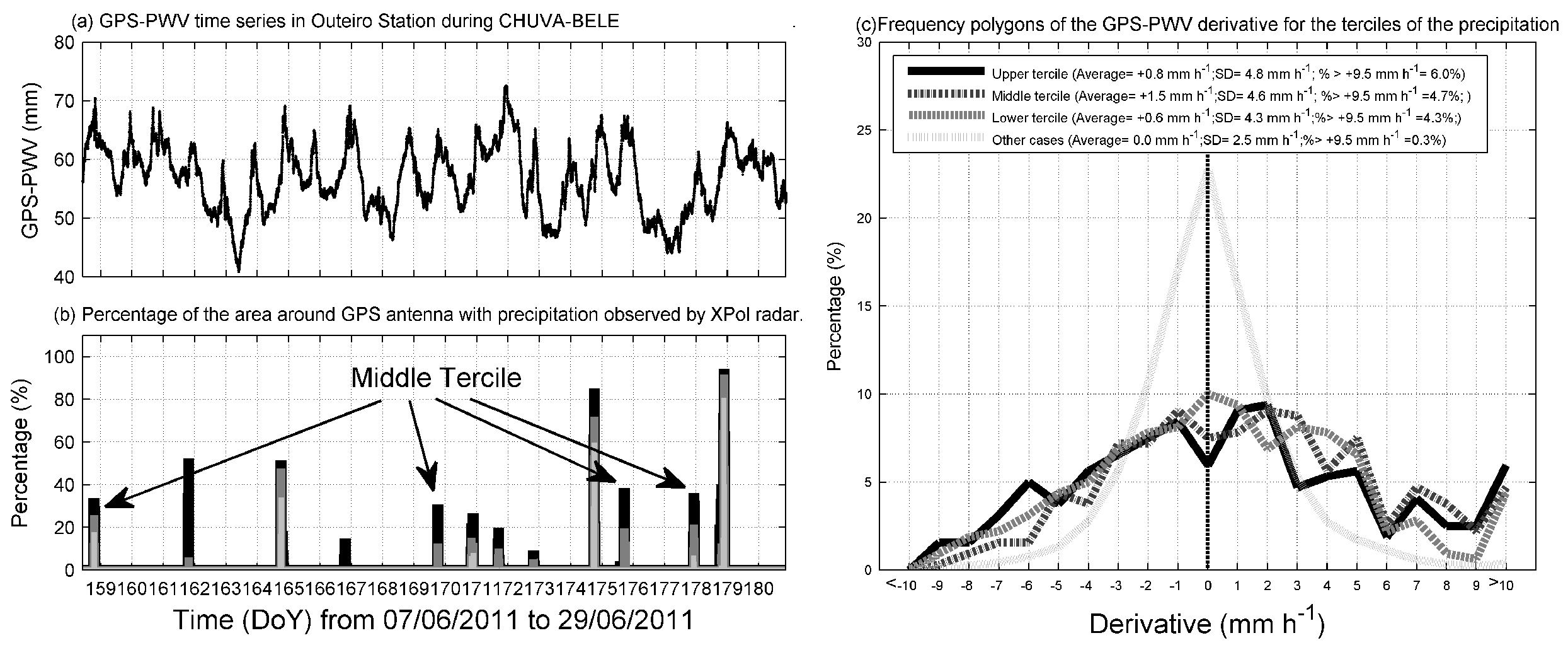
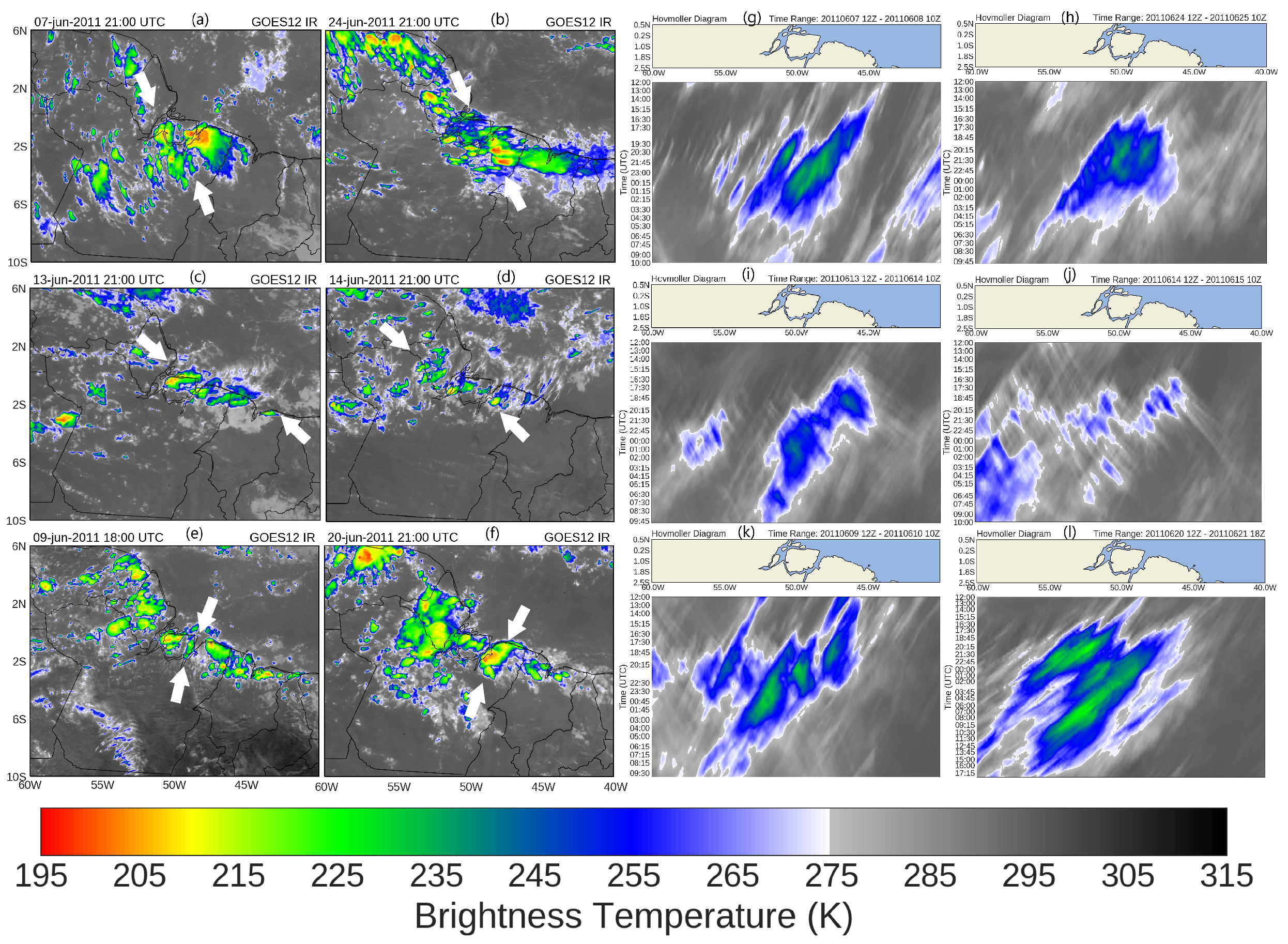

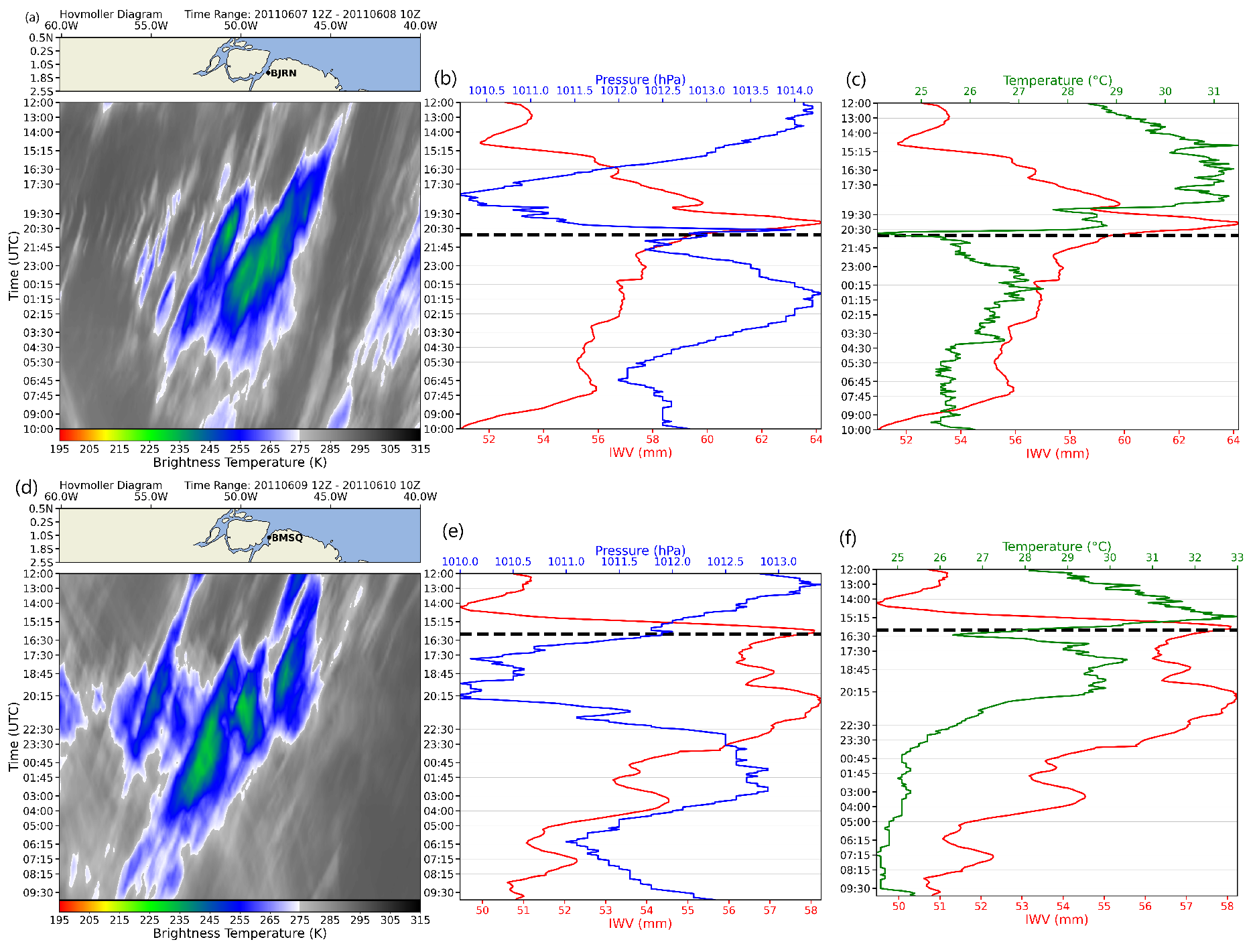
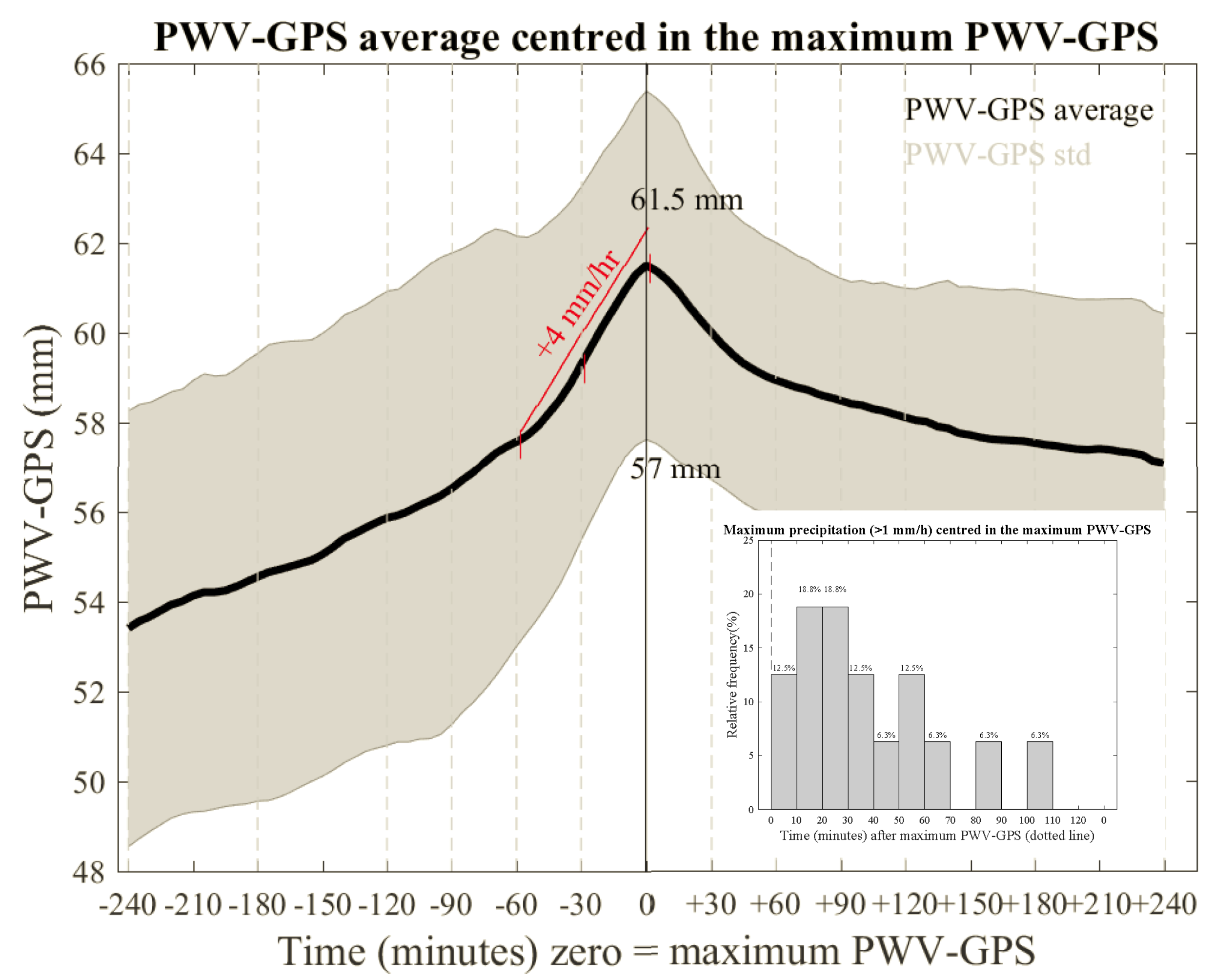
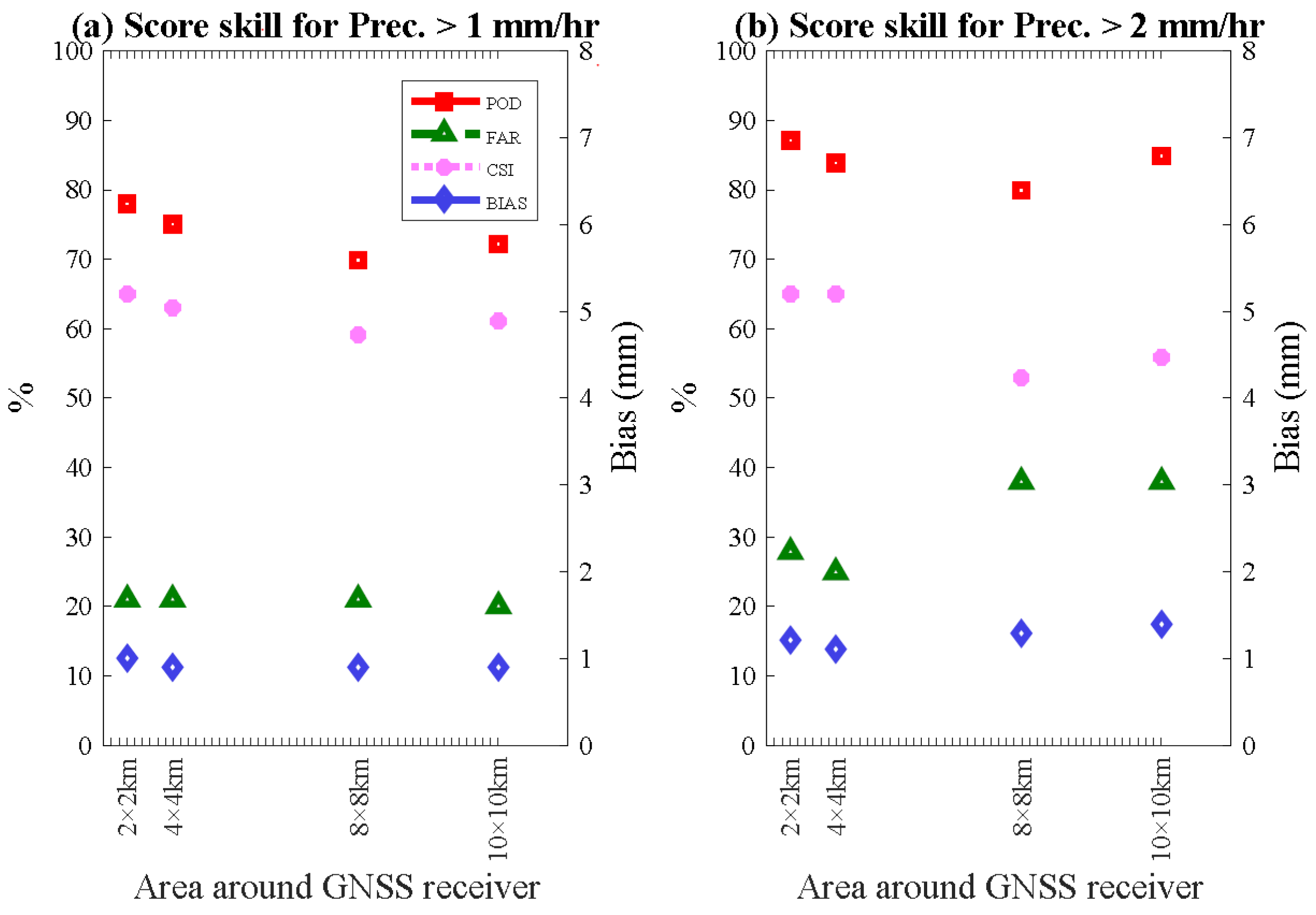


| GPS Station Name | Acronyms | Latitude | Longitude | Altitude | Meteorological Station: Brand/Model |
|---|---|---|---|---|---|
| São Miguel do Guamá-PA | BSMG | 1.62 S | 47.47 W | 10.97 m | Vaisala/PTU303 |
| Telégrafo-PA | BTLG | 1.4 S | 48.48 W | 6.27 m | Vaisala/PTU303 |
| Santa Isabel do Pará-PA | BSPC | 1.35 S | 48.13 W | 8.25 m | Vaisala/PTU303 |
| Vigia-PA | BSSG | 0.90 S | 48.10 W | 14.00 m | Vaisala/PTU303 |
| Abaetetuba-PA | BABT | 1.69 S | 48.79 W | 11.50 m | Vaisala/PTU303 |
| Vila dos Cabanos-PA | BVCB | 1.51 S | 48.68 W | 0.25 m | Vaisala/PTU303 |
| Jurunas-PA | BJRN | 1.47 S | 48.49 W | 3.00 m | Vaisala/PTU303 |
| Mangeirão-PA | BMGR | 1.37 S | 48.43 W | 3.27 m | Vaisala PTU303 |
| Águas Brancas-PA | BAGB | 1.38 S | 48.37 W | 5.09 m | Vaisala/PTU303 |
| Guamá-UFPA-PA | UFPA | 1.47 S | 48.45 W | 2.15 m | Davis |
| Mosqueiro-PA | BMSQ | 1.12 S | 48.43 W | 8.75 m | Vaisala/PTU303 |
| Soure-PA | BSOR | 0.72 S | 48.51 W | 10.29 m | Vaisala/PTU303 |
| SIPAM-PA | BSPM | 1.40 S | 48.46 W | 6.37 m | Davis |
| DTCEA-EMA-PA | BEMA | 1.38 S | 48.48 W | 9.83 m | Davis |
| Benevides-PA | BBNV | 1.30 S | 48.28 W | 13.63 m | Davis |
| Outeiro-PA | LGE1 | 1.26 S | 48.44 W | 14.56 m | Vaisala/PTU303 |
| Days | Ground-Based GPS |
|---|---|
| 7 | LGE1, BSPC, BTLG, BJRN, and BAGB |
| 24 | BTLG, BMSQ, BSSG, BJRN, and BAGB |
| 13 | BTLG, BMSQ, BSPC, BJRN, and BAGB |
| 14 | BTLG, BMSQ, BABT, BSPC, and BAGB |
| 9 | LGE1, BMSQ, BABT, BJRN, and BAGB |
| 20 | BSSG, BMSQ, BABT, BSOR, and BAGB |
| Days | Ground-Based GPS |
|---|---|
| 8 | LGE1 |
| 10 | BMSQ |
| 21 | BAGB, BMGR |
| 23 | BSOR |
| 30 | BMSQ |
| Precipitation from Organized Convective Systems | Precipitation from Not Organized Convective Systems | |||||
|---|---|---|---|---|---|---|
| Observed | Not Observed | Total | Observed | Not Observed | Total | |
| Index triggered | 235 | 80 | 315 | 5 | 16 | 21 |
| Index not triggered | 46 | 3959 | 4005 | 19 | 824 | 843 |
| Total | 281 | 4039 | 4320 | 24 | 840 | 864 |
| Score skill | Bias | 1.1 mm | 0.9 mm | |||
| POD | 84% | 21% | ||||
| FAR | 25% | 76% | ||||
| CSI | 65% | 13% | ||||
Disclaimer/Publisher’s Note: The statements, opinions and data contained in all publications are solely those of the individual author(s) and contributor(s) and not of MDPI and/or the editor(s). MDPI and/or the editor(s) disclaim responsibility for any injury to people or property resulting from any ideas, methods, instructions or products referred to in the content. |
© 2023 by the authors. Licensee MDPI, Basel, Switzerland. This article is an open access article distributed under the terms and conditions of the Creative Commons Attribution (CC BY) license (https://creativecommons.org/licenses/by/4.0/).
Share and Cite
Campos, T.B.; Sapucci, L.F.; Eichholz, C.; Machado, L.A.T.; Adams, D.K. The Sensitivityof GPS Precipitable Water Vapor Jumps to Intense Precipitation Associated with Tropical Organized Convective Systems. Atmosphere 2023, 14, 262. https://doi.org/10.3390/atmos14020262
Campos TB, Sapucci LF, Eichholz C, Machado LAT, Adams DK. The Sensitivityof GPS Precipitable Water Vapor Jumps to Intense Precipitation Associated with Tropical Organized Convective Systems. Atmosphere. 2023; 14(2):262. https://doi.org/10.3390/atmos14020262
Chicago/Turabian StyleCampos, Thamiris B., Luiz F. Sapucci, Cristiano Eichholz, Luiz A. T. Machado, and David K. Adams. 2023. "The Sensitivityof GPS Precipitable Water Vapor Jumps to Intense Precipitation Associated with Tropical Organized Convective Systems" Atmosphere 14, no. 2: 262. https://doi.org/10.3390/atmos14020262
APA StyleCampos, T. B., Sapucci, L. F., Eichholz, C., Machado, L. A. T., & Adams, D. K. (2023). The Sensitivityof GPS Precipitable Water Vapor Jumps to Intense Precipitation Associated with Tropical Organized Convective Systems. Atmosphere, 14(2), 262. https://doi.org/10.3390/atmos14020262








